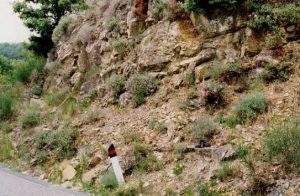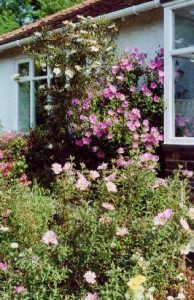Cistus & Halimiums
Cistus and halimiums are evergreen shrubs, native to the whole Mediterranean region, with an outpost in the Canary Islands (where a number of endemic species are found) and Madeira. They are important constituents of the flora of the maquis and garrigue (stony, arid, degraded scrublands), disturbed sites, such as roadsides, and very sandy soils.

Cistus creticus in Italy
They have showy flowers of white, pink or yellow, rather like single roses. Each day’s flowers are borne in great profusion but last for only a few hours, the petals falling to carpet the ground like nature’s confetti. These petals are often crumpled, like crushed silk and may have an attractive blotch at the base.
The leaves are always arranged in opposite pairs and are adapted in various ways to reduce water loss in the Mediterranean summer. Many are felted or covered with hairs of various kinds; others exude a fragrant, sticky gum called ladanum used in perfumery and folk medicine. (N.B. There is no connection with laudanum!)
They have symbiotic relationships with various fungi and mycorrhizae and are parasitised by plants of the genus Cytinus.
They produce large quantities of seed whose germination is influenced by fire and is the subject of considerable research.
Despite being Mediterranean plants, most are much hardier than generally supposed and thrive in our climate, given correct cultivation. (See page on hardiness)

A small part of the collection
For details of an up-to-date guide to Cistus & Halimium in cultivation in the U.K. click here.
